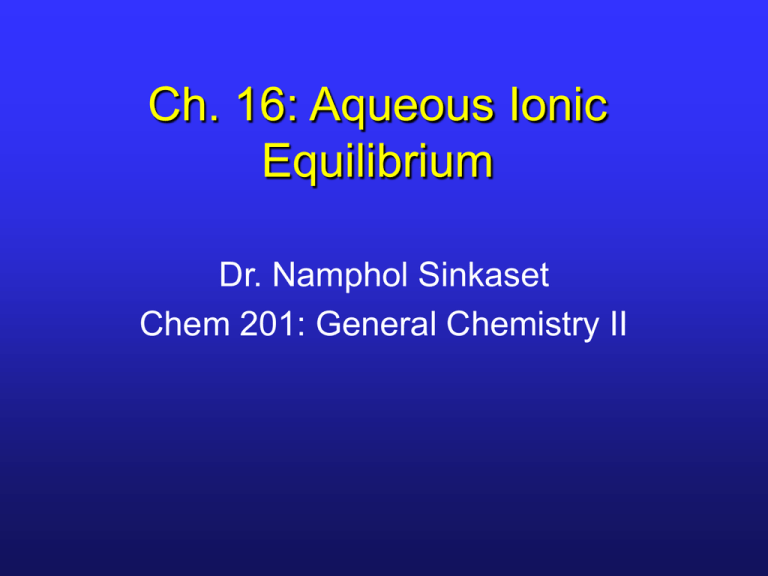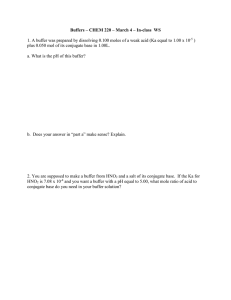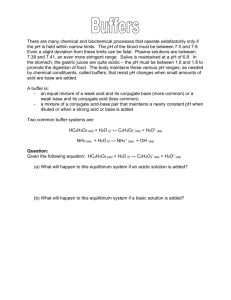Ch. 16a Slides
advertisement

Ch. 16: Aqueous Ionic Equilibrium Dr. Namphol Sinkaset Chem 201: General Chemistry II I. Chapter Outline I. II. III. IV. V. Introduction Buffers Titrations and pH Curves Solubility Equilibria and Ksp Complex Ion Equilibria I. Last Aspects of Equilibria • In this chapter, we cover some final topics concerning equilibria. • Buffers are designed to take advantage of Le Châtelier’s Principle. • Solubility can be reexamined from an equilibrium point of view. • Complex ions are introduced and their formation explained using equilibrium ideas. II. pH Resistive Solutions • A solution that resists changes in pH by neutralizing added acid or base is called a buffer. • Many biological processes can only occur within a narrow pH range. • In humans, the pH of blood is tightly regulated between 7.36 and 7.42. II. Creating a Buffer • To resist changes in pH, any added acid or base needs to be neutralized. • This can be achieved by using a conjugate acid/base pair. II. How the Buffer Works • For a buffer comprised of the conjugate acid/base pair of acetic acid/acetate: OH-(aq) + CH3COOH(aq) H2O(l) + CH3COO-(aq) H+(aq) + CH3COO-(aq) CH3COOH(aq) • As long as we don’t add too much OH- or H+, the buffer solution will not change pH drastically. II. Calculating the pH of Buffers • The pH of a buffer can be calculated by approaching the problem as an equilibrium in which there are two initial concentrations. • Since an acid and its conjugate base are both in solution, problem can be solved from a Ka or Kb point of view. II. Sample Problem • A solution was prepared in which [CH3COONa] = 0.11 M and [CH3COOH] = 0.090 M. What is the pH of the solution? Note that the Ka for acetic acid is 1.8 x 10-5. II. Sample Problem • A student dissolves 0.12 mole NH3 and 0.095 mole NH4Cl in 250 mL of water. What’s the pH of this buffer solution? Note that the Kb for ammonia is 1.8 x 10-5. II. A Special Buffer Equation • Buffers are used so widely that an equation has been developed for it. • This equation can be used to perform pH calculations of buffers. • More importantly, it can be used to calculate how to make solutions buffered around a specific pH. II. Henderson-Hasselbalch Eqn. II. The H-H Equation • The Henderson-Hasselbalch equation works for a buffer comprised of conjugate acid/base pairs. • It works provided the “x is small” approximation is valid. II. Sample Problem • A student wants to make a solution buffered at a pH of 3.90 using formic acid and sodium formate. If the Ka for formic acid is 1.8 x 10-4, what ratio of HCOOH to HCOONa is needed for the buffer? II. Sample Problem • A researcher is preparing an acetate buffer. She begins by making 100.0 mL of a 0.010 M CH3COOH solution. How many grams of CH3COONa does she need to add to make the pH of the buffer 5.10 if the Ka for acetic acid is 1.8 x 10-5? II. Upsetting the Buffer • A buffer resists changes to pH, but it is not immune to change. • Adding strong acid or strong base will result in small changes of pH. • We calculate changes in pH of a buffer by first finding the stoichiometric change and then performing an equilibrium calculation. II. Illustrative Problem • A 1.00 L buffer containing 1.00 M CH3COOH and 1.00 M CH3COONa has a pH of 4.74. It is known that a reaction carried out in this buffer will generate 0.15 mole H+. If the pH must not change by more than 0.2 pH units, will this buffer be adequate? II. Stoichiometric Calculation • When the H+ is formed, it will react stoichiometrically with the base. • We set up a different type of table to find new equilibrium concentrations. • We use ≈0.00 mol because [H+] is negligible. H+ Initial Change Final 0.15 mol -0.15 mol ≈0.00 mol + CH3COO- 1.00 mol -0.15 mol 0.85 mol CH3COOH 1.00 mol +0.15 mol 1.15 mol II. Equilibrium Calculation • We use the new buffer concentrations in an equilibrium calculation to find the new pH. • Again, use ≈0.00 M because [H3O+] is negligible. CH3COOH + H2O H3O+ + CH3COOInitial Change Equil. 1.15 M ---- ≈0.00 M 0.85 M -x ---- +x +x 1.15 – x ---- x 0.85 + x Solve to get [H3O+] = 2.44 x 10-5 M, and pH = 4.613. II. How the Buffer Works II. A Simplification for Buffers • In buffer problems, # of moles can be used in place of concentration. • This can be done because all components are in the same solution, and hence have the same volume. II. Sample Problem • Calculate the pH when 10.0 mL of 1.00 M NaOH is added to a 1.0-L buffer containing 0.100 mole CH3COOH and 0.100 mole CH3COONa. Note that the Ka for acetic acid is 1.8 x 10-5. II. Buffers Using a Weak Base • Up until now, we’ve been creating buffers with a weak acid and it’s conjugate base. • Can also make a buffer from a weak base and its conjugate acid. • Henderson-Hasselbalch still applies, but we need to get Ka of the conjugate acid. II. pKa/pKb Relationship II. Sample Problem • Calculate the pH of a 1.0-L buffer that is 0.50 M in NH3 and 0.20 M in NH4Cl after 30.0 mL of 1.0 M HCl is added. Note that the Kb for NH3 is 1.8 x 10-5. II. Making Effective Buffers • There are a few parameters to keep in mind when making a buffer: The relative [ ]’s of acid and conjugate base should not differ by more than factor of 10. The higher the actual [ ]’s of acid and conjugate base, the more effective the buffer. The effective range for a buffer system it +/1 pH unit on either side of pKa. II. Buffer Capacity • Buffer capacity is defined as the amount of acid or base that can be added to a buffer without destroying its effectiveness. • A buffer is destroyed when either the acid or conjugate base is used up. • Buffer capacity increases w/ higher concentrations of buffer components.






